
HERE, IN THE THIRD of a long multi-part series, is how we reported the career of Steve Prefontaine in our pages from the fall of ’70 through the summer of ’71, with the same photographs we used at the time. We have taken the liberty of doing some stylistic updatings to mirror our modern protocol and also added an editorial comment or three:
November 1970: Prefontaine Front Runs 30:11.8 ln Slop, Cold
Pullman, Washington, November 14—Strong cold winds and a muddy course slowed Steve Prefontaine to 30:11.8 in the Pacific 8 overland race, almost 25 seconds off his winning time here in the Northern Division two weeks earlier. But most others were equally hampered, and Pre slopped to the title which had so narrowly evaded him last year. Reviving his frontrunning tactics, Pre faced early pursuit from frosh teammate Randy James, but opened up a lead of 20y on the field in the first 440, and was never headed. /Bob Payne & Jim Dunne/
December 1970: NCAA—Prefontaine In Command
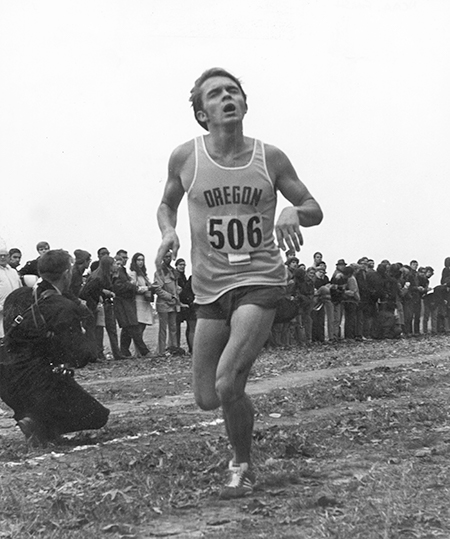
Williamsburg, Virginia, November 23—Steve Prefontaine pulled away from the rest of the field in the fourth mile and won the 32nd annual NCAA Cross Country title with a swift 28:00.2 for 6M. And Villanova won a real squeaker for its fourth championship in the last five years when, 24 hours after the race, the meet officials moved its fifth man from 67th to 62nd after viewing the meet films. This turned an unofficial 86–88 Oregon victory into an official 85–86 Villanova triumph. Defending champion El Paso was a distant 3rd with 124 points.
Prefontaine followed Western Michigan’s Jeromee Liebenberg through a 4:25 mile. He then led a bunched pack through 2M in 9:10 and 3M in 14:00. Normally a frontrunner, Pre followed his usual suit and made a significant move at 3½M, which left him in command thereafter. “If I had to make it or break it, I felt I had to do it when everybody else was resting for the finish,” he said afterwards.
He clocked 18:42 for 4M, 23:23 for 5M and his final time of 28:00.2 broke the neophyte course record by 1:40. He defeated runner-up Donal Walsh of Villanova, the IC4A champion, by about 8 seconds. Walsh’s 2nd surprised many observers, as they felt he didn’t have sufficient speed for the course. His final time was 28:08.
Other relative newcomers dotted the top places. Don Kardong of Stanford was 3rd in 28:10, followed by Greg Fredericks of Penn State in 28:12, John Bednarski of El Paso in 28:14 as well as Keith Munson of Oregon State in 28:22.
Coming down the homestretch, Prefontaine looked over his shoulder several times and appeared ready to collapse. He was literally dragged down the chute by meet officials. But he recovered quickly, and was mobbed by spectators and reporters immediately afterwards. “At 3½M, I dared the field to run with me,” he said. Nobody could.
From this race, it would appear that Pre may fill the distance running void left when Gerry Lindgren graduated. The hoped-for Prefontaine/Garry Bjorklund dual never materialized, as Bjorklund had an appendectomy the week before the race. /Shelby Hawthorne/ — Click here for meet results —
January 1971: The U.S. Rankings
Pre repeated as No. 3 in the 3M/5000 for ’70.
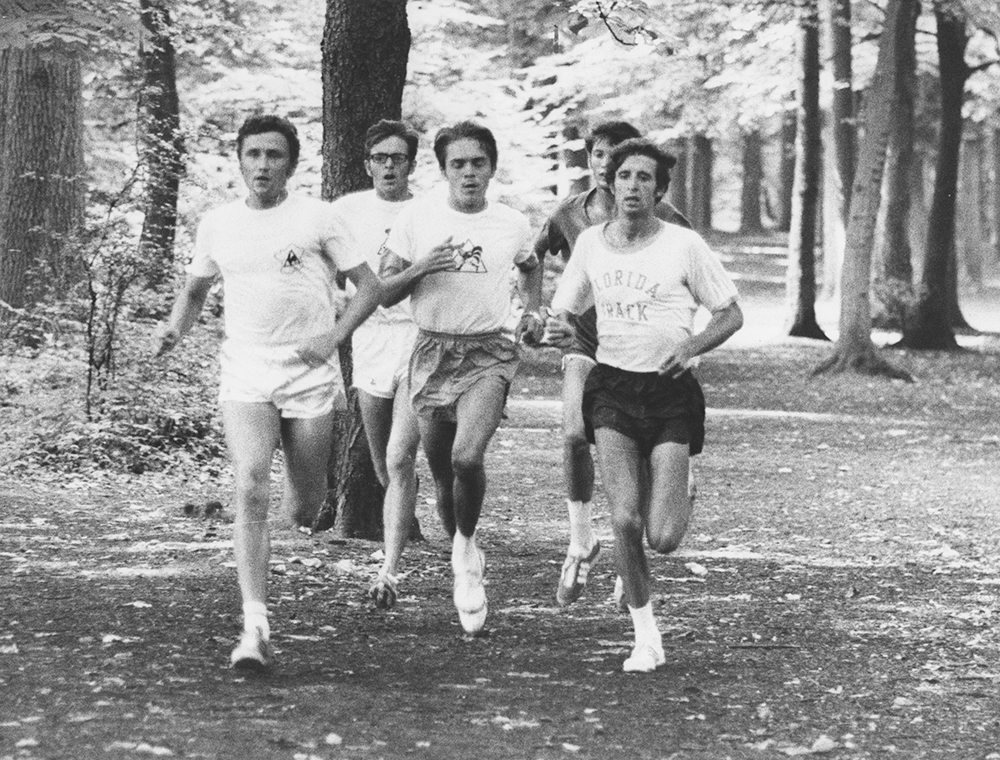
I February 1971: Prefontaine Runs 8:31.6
Portland, Oregon, January 30—The Oregon Invitational upheld its tradition as one of the finest long-distance meets in the country as a turnaway capacity audience of 9936 cheered Steve Prefontaine to a blistering 8:31.6 in the 2M, the =sixth-fastest undercover effort ever.
Following the early pace-setting of Gerry Lindgren, Pre soon shook all challengers, passing the mile mark in 4:15. Completely annihilating the classy field, Pre lapped both Lindgren and Ken Moore, and left 2nd-placer Arne Kvalheim far in arrears at 8:48.6. After the race, a grinning Pre said, “Yeh, I might as well admit it, I was shooting for the World Record [of 8:27.2].” Talk is rampant now in Oregon of a Pre/George Young confrontation. /Bob Forbes/
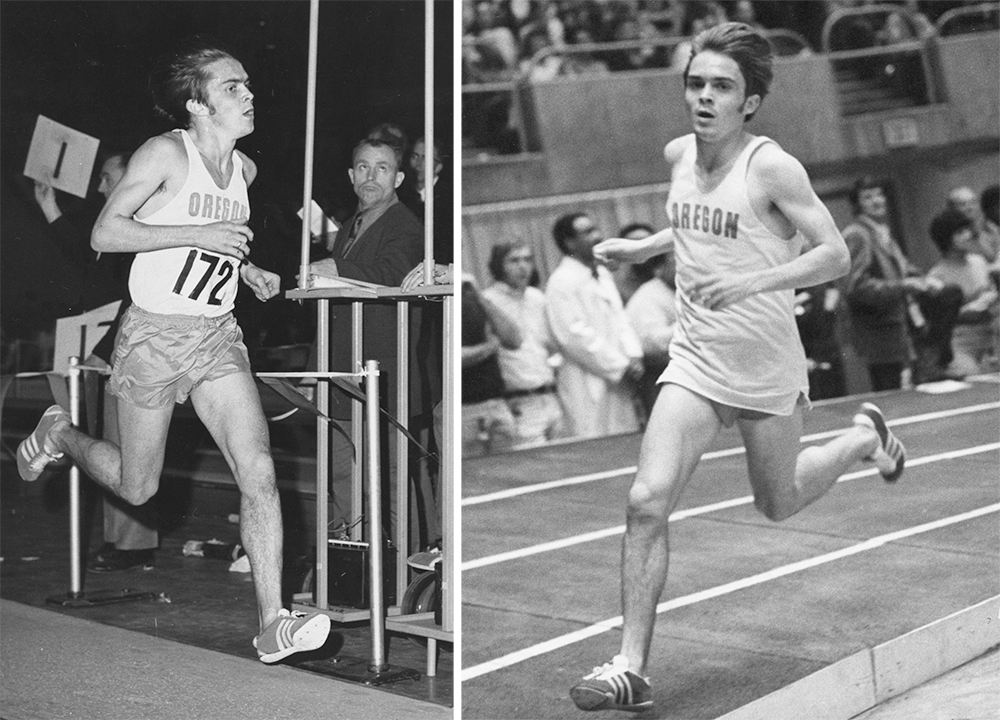
II February 1971: Prefontaine Solos 8:34.4
Oakland, California, February 13—Massive Randy Matson and slight Steve Prefontaine respectively muscled and hustled their way to outstanding performances before 9506 patrons at the fifth Athens Invitational…
Prefontaine said before the 2M he had seen the results from Los Angeles the night before (Kerry Pearce 8:30,0, etc.) but that he would “just run.” So he carved out a pace which few runners could survive—and eventually succumbed himself. He burst to the front from the gun, pulling little Rashid Sharafyetdinov with him and covered the first four quarters in the staggering splits of 61.7, 2:05.5, 3:07.5 and 4:10.5. The Soviet had given up the chase at the 880 but Steve pressed on. The first mile took its toll between 1¼ and 1½M as he dropped off drastically. But he mustered a last-lap kick to finish with 8:34.4, lapping Sharafyetdinov, Don Kardong and Arvid Kretz just before the wire. Kardong outlegged the Soviet for 2nd, 8:57.0 to 8:57.6.
“No, I didn’t intend to run fast,” Prefontaine said later. “But my coach said to run how I felt and I felt good early so I ran fast. I was experimenting. I was psychologically ready at Portland [where he turned a quick 8:31.6] but I wasn’t tonight. I would have run 9:00 if I had to.” Pre collected track athlete honors for his heroics. /Jon Hendershott/
I April 1971: Prefontaine’s 8:33.2, 4:00.2, 13:01.6 Lead U.S.
Steve Prefontaine is hot. In three weeks of competition since the II March T&FN, the precocious Oregon soph has zipped 1, 2, and 3M in 4:00.2, 8:33.2 and 13:01.6 to equal a Collegiate Record, set two PRs, and leads the nation in all three events…
Pre’s seasonal debut was in a 2M at Eugene on March 20. Following coach Bill Bowerman’s orders, he stayed behind the pack for the first mile, a dawdling 4:28.0. Then he took off, covering the last mile in a blistering 4:05.2, for a Collegiate Record-equaling 8:33.2…
On the 27th, Prefontaine moved south to San Diego to record the second-best mile of his career, 4:00.2, covering the last quarter in 58.2…
Back home in Eugene, on April 3, Pre once more unleashed a mighty race, covering 12-laps in a blistering 13:01.6, a time bettered by only four others in world history. And after he finished, he said, “I just ran like I felt. I’m sure I can run much faster than I did today, but I don’t want to predict a time.” Stanford’s Arvid Kretz got a PR by almost 30 seconds with his runner-up 13:32.0 but Pre’s margin on him was even greater than that.
II April 1971: Outdoor Report
The issue’s by-event recap noted a 4:02.6/8:36.2 double against Washington.
I May 1971: On Your Marks
…An interesting exchange transpired between Oregon distance runner Steve Prefontaine and UCLA coach Jim Bush following the schools’ dual meet which the Californians won. Said the soph, “I would have doubled if the meet had depended upon it but since we were out of it, there was no point. Why torture yourself. Our coach [Bill Bowerman] doesn’t use his athletes. Look at [Wayne] Collett. He could hardly stand up after running the intermediates. Maybe he likes to run a lot of events [it was his third of four races that day] but physically it takes a lot out of you.”
Replied Bush, “Prefontaine’s mouth is now running faster than his legs. He’s only a sophomore, and when he starts rapping coaches it’s a little hard to take. This is just a youngster. He’s always popping off. What we’re trying to do is build up track & field.” /Dick Drake/
II May 1971: Outdoor Report
The issue’s by-event recap noted a 3:59.1 against UCLA, an 8:42.4 against Oregon State and a 13:34.0 vs. Cal.
I June 1971: Pac-8
Seattle, Washington, May 22—The Pacific 8 Conference Championship was chock full of its usual high quota of stars, superstars, heroes, comethroughs and surprises… Steve Prefontaine pushed to impressive [same-day] mile/3M times… Prefontaine casually won the mile in 4:01.5 as two teammates, Rick Ritchie and Knut Kvalheim, followed him home.
But the heat started getting even to the great Pre in the 3M as Stanford’s Don Kardong actually took the lead for a time during the last mile. “I was running on pure guts,” Steve said. “If Kardong had poured it on with 3 laps to go, I would have let him go. “ But Don didn’t have it, and with 660 left Steve ran away from him for victory in 13:18.0. It didn’t break any records but certainly was one of the toughest races of his life. Kardong claimed a PR by 7.2 seconds with his 13:20.8. /Jack Pfeifer/
II June 1971: Kvalheim Tags Pre as Ryun Comeback Snags
Eugene, Oregon, June 6—Jim Ryun’s comeback ran into a serious snag as Arne Kvalheim’s stock shot upward following his decisive win over Ryun and Steve Prefontaine in the Oregon Twilight mile.
Strong and confident although weeks away from peak form, Kvalheim eased across the finish line in a career best of 3:56.4. Prefontaine, whom many of the rabidly enthusiastic overflow crowd of 11,200 thought to be the most worthy challenger of King Jim, ran a PR-equaling 3:57.4, which he also clocked here last year in 2nd. And a host of other Oregonians also finished before a dispirited Ryun finally reached home in 4:07.6, beaten into an ignominious 10th place by an invisible foe, the infamous Eugene pollen.
Violently attacked by what is commonly known as hay fever, Ryun was unable to breathe properly and hence unable to pump throughout his body the oxygen necessary to perform well at all distances longer than a sprint. He was a sad shadow of the Ryun who pushed Marty Liquori to 3:54.6, even then beginning to feel the effects of the pollen which well may peak just in time for the AAU Championships in Eugene June 25 and 26. Now the world’s fastest ever miler faces the problem of whether or trot he can continue to live and train in Eugene.
Inevitably, Ryun’s shocking setback took some of the luster off Kvalheim’s win. But forgetting about Ryun, it was a smashing triumph for the Norwegian graduate student. In only the fourth race of a deliberately slow-paced campaign which is to climax at the European Championships in August, Arne approached in quality his career best of 3:38.5 for 1500m. And he won convincingly.
Pre took over from rabbit Nils Emilsson, picking up the pace as he passed the mid-point in 2:00.3. He and Arne broke away, leaving Ryun, who already was off the pace in 6th place, buried in the middle of the quickly receding pack. Jim never could respond and attention was riveted on the spirited race up front with only occasional, unbelieving looks at the floundering Ryun. Pre buzzed past the gun in 2:59.9 with the taller, smoother Kvalheim 4ft back. That’s the way it was until the last curve when Arne (“I never kick more than 165y as I tie up if I try it”) made his move. He was well ahead into the final straight and missed Roscoe Divine’s field record by a 10th when he thrust both arms aloft in victory and eased up in the last 10y. (“I always do that when I win.”) /Bert Nelson/
I July 1971: NCAA 3M
Seattle, Washington, June 19—The least impressed of all NCAA winners must have been Oregon’s Steve Prefontaine, who said, “This has to rank way down the list of thrills for me. I needed a good workout, and that’s about what I got. I wasn’t too psyched up for this race. I wanted to run as slow as I could to win and that’s what I did. I’ve got a big meet next week.”
While Pre might have been thinking more of the coming AAU race, he proved here that even at partial concentration he is nonpareil among current collegiate 3-milers with a decisive 13:20.2 victory.
Forging the pace from the beginning, Pre was alone with IC4A champ Greg Fredericks of Penn State by 1½M. As the pair entered the straight ending the seventh lap, Pre moved into the second lane, motioning to his rival to assume the lead. After several invitations, Fredericks went to the fore, crossing the line in 7:42 and opening a surprising yard lead down the backstretch. Pre moved out beside Fredericks coming down the straight as the pair passed 2M in 8:54.0 after a slow 72 second-lap.
Unhappy with the slow pace forged by Fredericks, Pre immediately threw in a 65, which opened the gulf between the two to 5y. Pre’s surges gave him close to a 50y lead by the bell and he finished easily, waving one hand to the crowd up the final stretch. “It was all according to plan,” said Pre. “Someone told me he has a good sprint so I threw in some fast laps to see how much of a sprint he would have left.” Fredericks recorded a PR 13:28.0 in finishing 2nd. /Garry Hill/
I July 1971: AAU 3M
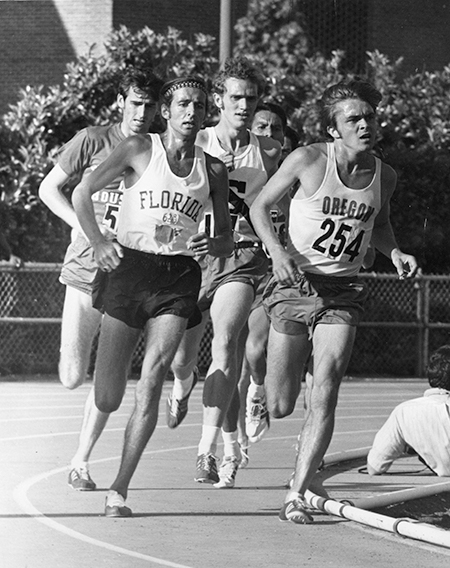
Eugene, Oregon, June 26—The fastest mass 3M race ever run was wind-aided by thousands of rabid Oregon fans cheering for their own Steve Prefontaine.
The emotional crowd and the fast, sand-colored Proturf track contributed to a fast pace with runners bunched at the mile in 4:18.3. Last year’s runner-up, Rick Riley, was already letting them go, 40y behind in the warm, sunny weather. At 1¾M, 8 runners were still bunched. Greg Fredericks, suffering from a fatigue fracture, was now 50y behind.
Then, to the rising excitement of the crowd, sturdy little Prefontaine kept his green and yellow uniform in front with a 65.8 lap and the others began to string out behind him. At 2M in a sizzling 8:42.4, Gerry Lindgren had a 4y gap in front of him and little Paul Lightfoot was letting them get away from him.
With two laps to go, courageous Tarry Harrison was beginning to lose contact, Then Prefontaine ran a lap in 63.7, shaking off everybody except the surprising Steve Stageberg who clung to his shoulder.
Around to the backstretch, Stageberg held on and the crowd’s screaming seemed almost desperate. Frank Shorter could no longer keep up with Pre’s 58.8 pace and he was 10y back. Lindgren was fighting hard another 20y behind. Mario Pérez of Mexico was fading away, and tall Leonard Hilton, in the red of Houston, passed him.
Into the last turn, Pre began to pull away and there was joy in Eugene. He won by 10y. Shorter eased in 3rd, but Lindgren had to run hard all the way to hold off Hilton.
Prefontaine’s 12:58.6 makes him the fifth-fastest 3-miler ever and the second-fastest American. The amazing Stageberg is now seventh and third with his 13:00.4. Shorter is eighth and fourth with 13:02.4. Hilton, who was actually missed by the finish judges, moved to 10th and fifth. Pérez, new Mexican recordholder, is now 14th fastest of all-time with his 13:07.4. And Harrison’s 13:08.4 failed to place.
Prefontaine, who loafed in the NCAA to save himself for this one, ran his last 880 in 2:02.5 in his hard-won victory. He said, “I had a lot left.”
He received a huge ovation every time he walked or jogged past the stands and he kept coming back for more, smiling and waving. “Beautiful, just beautiful,” he said. “These are my people. Just fantastic. How can you lose with 12,000 people behind you?” /Cordner Nelson/
I July 1971: U.S./USSR/World All-Stars 5000
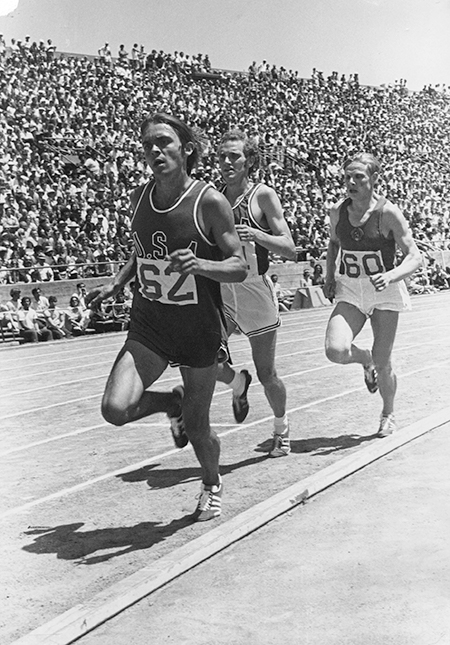
Berkeley, California, July 3—“I think I’m getting stronger each week,” said Steve Prefontaine when asked about the effects of running hard races three weekends in a row. And the confident little Oregonian looked it as he finished strongly for a new U.S. Record of 13:30.1.
The Soviets didn’t figure to match the young but talented American duo and the pre-meet figuring was right. Anatoliy Vyerlan was dropped before the midway point and Vladimir Afonin had to let go as the pace quickened just before the gun. Meanwhile, Pre and Steve Stageberg had divided the pacing chores with Pre leading at the mile in 4:17.4 and at 2M in 8:43.0. Pre finally moved away down the last backstretch and, with the national record in sight, poured it on all the way through a 58.7 last circuit.
“I felt bad in the middle of the race,” he remembered, but at the end he was his usual self, victorious and happy with the world and his position in it. /Bert Nelson/
II July 1971: U.S. vs. Africa
[Ed: by the next year, the previously unknown “Mirus Ifter” had had his name properly rendered as Miruts Yifter.]
Durham, North Carolina, July 17—After the fantastic accomplishments of African distance stars in the last decade, nothing should have come as a surprise at the first appearance of an African team in this country. But Mirus Ifter shocked everyone at Durham, turning his first exposure to international competition from despair to triumph in two stunning races.
Ifter began his 2-day tour of the depths and heights of running in Friday’s 5000m event. The race began routinely. Although the pace through the first two miles (4:25.3, 9:01.2) was pedestrian considering the level of competition, the 87° heat took its toll and only Ifter was able to keep up with Steve Prefontaine. With two laps to go, these leaders had pulled well away from the field which included Ethiopian Paul Moses, AAU runner-up Steve Stageberg and Tunisian Zadden Abdelkadir, reportedly a brother of Olympic 5000 champion Mohamed Gammoudi.
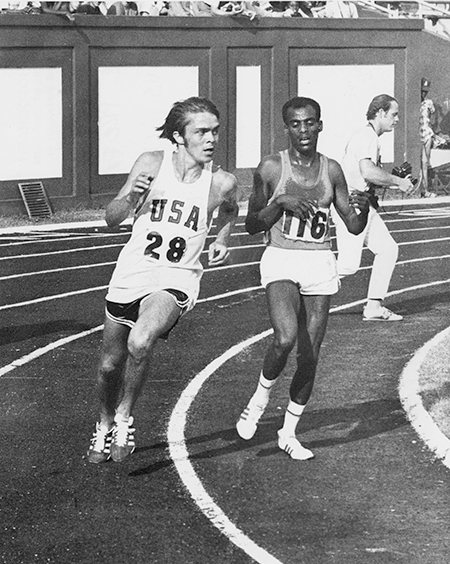
Some 700y from the finish, Ifter started a sizzling kick. Prefontaine kept up only briefly before letting the Ethiopian go, which proved to be a wise move. Before long, Ifter had opened up a 25y lead. But as Ifter crossed the finishline with one to go, he threw up his hands victoriously and stopped running, obviously believing he had won the race. Almost simultaneously, the starter fired the gun for the start of the last lap, but Ifter, suffering from lack of comprehension of what had happened—or from exhaustion, or both—could not be convinced to run another lap. Prefontaine plodded through a 70-second final lap to break the tape [in 13:57.6]…
One question which did get a clear answer was Ifter’s opinion of what would have happened if he had counted correctly—would he have beaten Pre? “Absolutely,” he said through an interpreter. After observing lifter’s “final” lap, which was clocked in 57.6, many believe him.
The young Oregonian was not among them. “When he took off like that I figured that either he had miscounted the laps or that he was just testing me to see how strong I was. I was prepared to come back at him on the last lap, though.” Prefontaine added that he thought that Ifter’s misfortune was “really a tragedy—I feel sorry for him”. Bob Hersh & Jim Dunaway/
[Ed: The next day in 91° heat and stifling humidity, Ifter/Yifter ran the 10,000 as a non-scoring, though crowd-pleasing, entry. His 59.6 last lap held off Frank Shorter by 5 yards for a 28:53.2 win. Pre, guest commentating for CBS, exulted, “I can’t believe this—it’s fantastic.”]
August 1971: Pan-Am Games
Cali, Colombia—It wasn’t mentioned in the news story, but Pre finished his year with an altitude-slowed 13:52.6 win over Steve Stageberg in the Pan-Am 5000.
Previously in the Pre Chronicles…
Part 2: The Frosh Year At Oregon